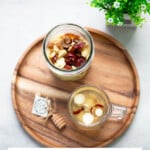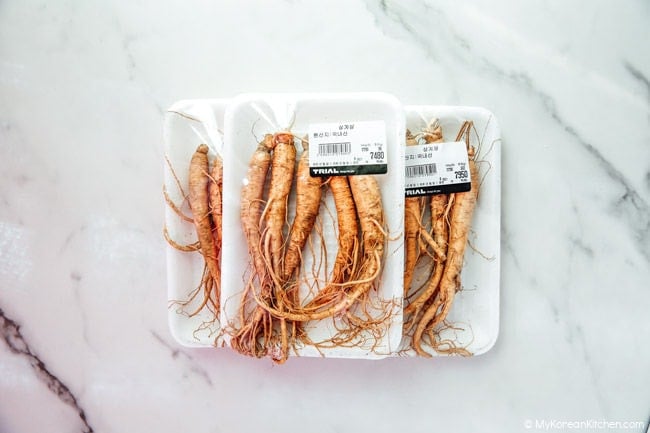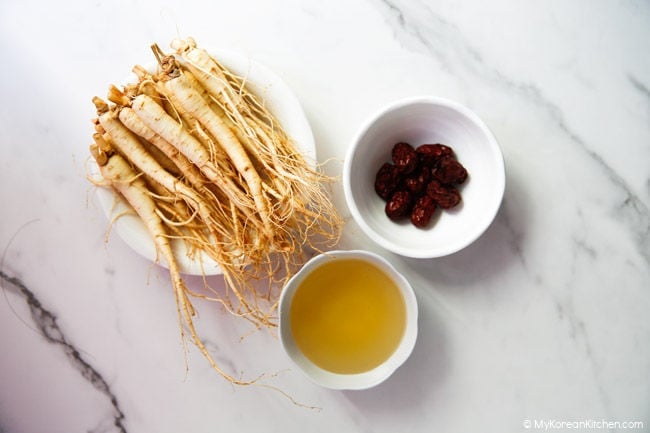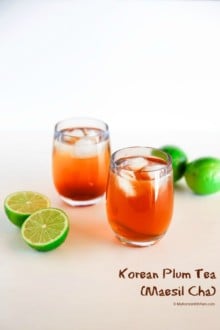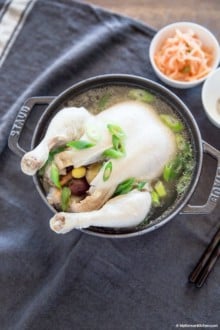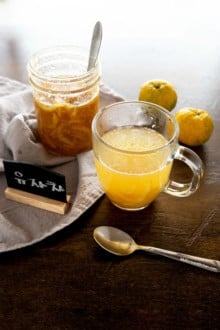Ginseng tea is a herbal drink made from the roots of the Panax Ginseng plant. The tea has been used for centuries in Korea and is believed to have many health benefits. If you’re interested in learning how to make it at home, here’s my easy ginseng tea recipe. Give it a try soon!
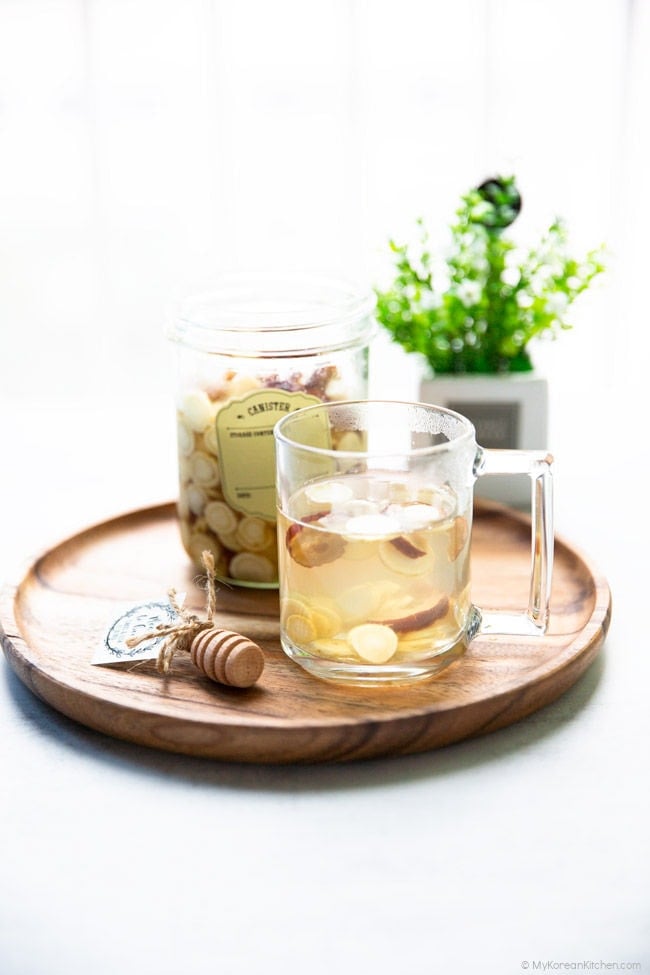
What is Ginseng
Ginseng (Insam, 인삼) is a plant that has been used for centuries in traditional medicine. It is believed to have many health benefits, including boosting the immune system, improving mental clarity and reducing fatigue.
It is native to north eastern Asia and North America and it can be consumed in many ways, such as raw root or tablets. One of the most popular ways is to take it as tea, called ginseng tea (Insam cha, 인삼차).
Korean Ginseng Tea
Ginseng tea is a herbal drink made from the roots of the ginseng plant. Traditionally, to make it, boil the roots and then strain it to produce a light brown liquid. It is typically served with honey to sweeten the tea; without honey, it can taste bitter.
Recently, a popular method of preparing ginseng is to slice it and marinate it in honey. This allows the ginseng to develop more sweet flavor. When serving, the Ginseng Honey Marmalade is mixed with warm water. This dish is called Insam-Kkuljeolim (인삼 꿀절임) or Insam-Kkulcheong (인삼꿀청) in Korea.
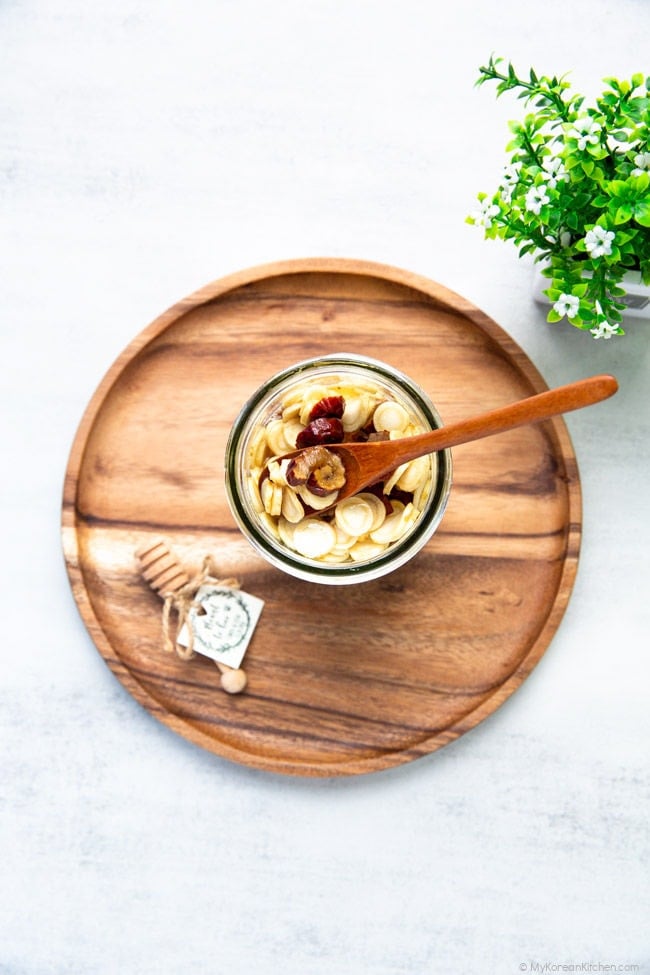
Benefits of Ginseng
Ginseng tea is a popular Korean tea that has been used for medicinal purposes for centuries. Some of the potential health benefits associated with drinking ginseng tea include anti-aging properties, improved mental health, a boosted immune system, and regulated blood sugar levels.
If you want to learn more about the benefits of ginseng tea, check out this article. While ginseng tea is generally safe to drink, it is important to be aware of potential side effects before consuming it.
Where to Buy Ginseng
Fresh Korean ginseng can be easily found in Korea from large marts, traditional markets, or even online stores. However, it may be difficult to find fresh ginseng outside of Korea.
If you are unable to find fresh ginseng, you may be able to find dried ginseng and make the tea. If you are using dried ginseng, it is best to use the traditional method of making ginseng tea as making marmalade style would be difficult.
Red Ginseng
I sometimes buy a ginseng product called Hong Sam Jeong (홍삼정) for my family. The word “hongsam” means red ginseng, and Hong Sam Jeong is made with 6-year-old red ginseng. It is a type of ginseng extract; it has a dark brown, almost black color, and a very thick consistency.
To make a quick ginseng tea, dissolve a small spoonful of it in warm water. If you don’t mind eating it as is, you can eat it by the spoonful. If this is something you might like to do, this product is more readily available than fresh ginseng.
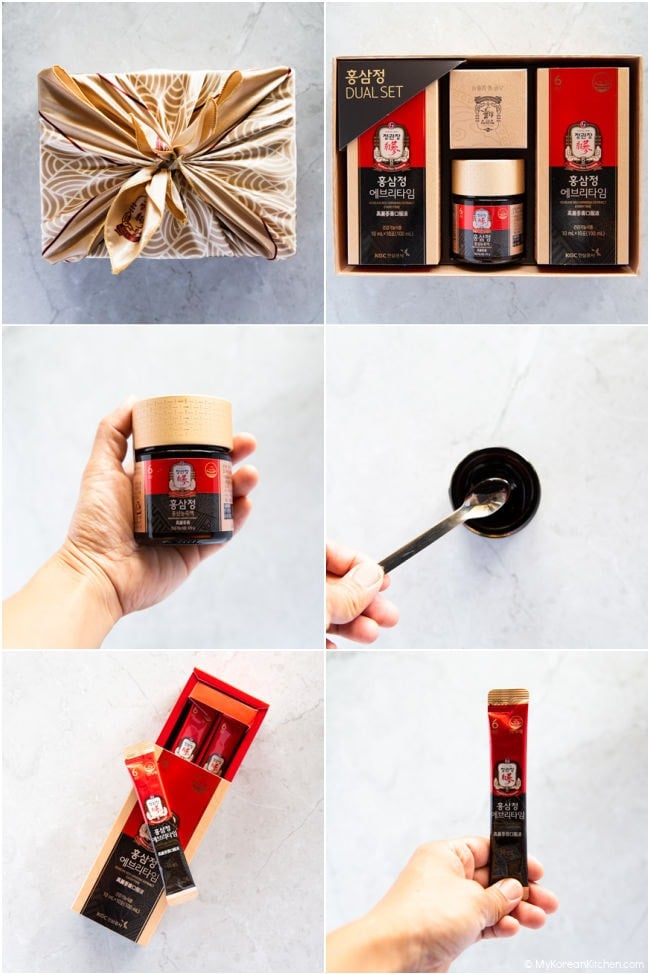
Also, Korean red ginseng extract is available in both a bottle and a stick. The bottle extract is more concentrated, while the stick is less intense.
As far as convenience goes, the stick is more user-friendly as it comes in individual packages and you don’t need to clean up afterwards. You may have seen Korean actors and actresses eating this in some Korean dramas.
My Best Tips
Ginseng tea is typically made with one part ginseng to one part honey. But the specific amount of honey can vary depending on the type of honey used. Sometimes more honey is necessary so that the ginseng is fully submerged and not exposed to oxygen, which can cause it to spoil. To reduce the likelihood of this happening, it’s best to use more honey.
How To Store
Ginseng tea (ginseng honey marmalade version) is recommended to be stored in an airtight glass container and left at room temperature for one day before being transferred to the refrigerator. While storing at room temperature, store it in a cool, dry place. It should be kept away from direct sunlight or excessive heat sources.
Once the ginseng is brewed, it’s ready to drink after just one week. However, for a more complex flavor profile, it’s best to wait 4-5 weeks before enjoying it. (But it’s OK to drink earlier if you can’t wait that long!) I recommend storing the bottle in the fridge during this time.
To avoid cross-contamination, only use a clean spoon when serving. Once opened, it should be used within 2 to 3 months.
Ingredients for Ginseng Tea
- 150g / 5.3 ounces ginseng, fresh
- (optional) 20g / 0.7 ounces dried jujube (Chinese dates), pitted
- 150g to 225g / 5.3 to 7.9 ounces honey
* The above ingredients will fit in a 490ml container. Glass is recommended. Be sure to sterilize it well beforehand.
How To Make Ginseng Tea
1. Make sure to wash your ginseng thoroughly under running water. Use a small brush to scrub away any dirt or debris between the fine roots. Pat the ginseng dry with kitchen paper, and then let it air dry. It is important to dry ginseng well, so it doesn’t develop mold during storage.
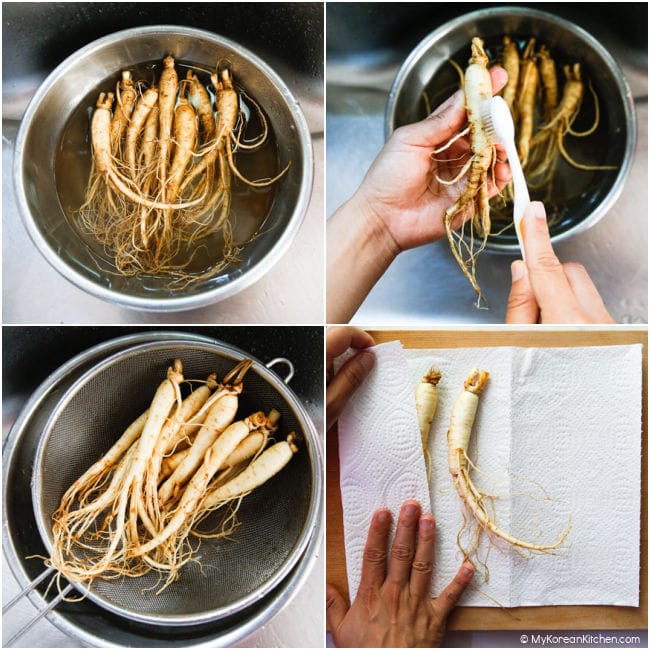
2. To prepare the ginseng, cut off the top end and discard it. Trim off the fine roots on the sides of the ginseng, and reserve them for other dishes (e.g. samgyetang). Slice the ginseng thinly. Some people like to finely chop their ginseng, but slicing gives a prettier finish.
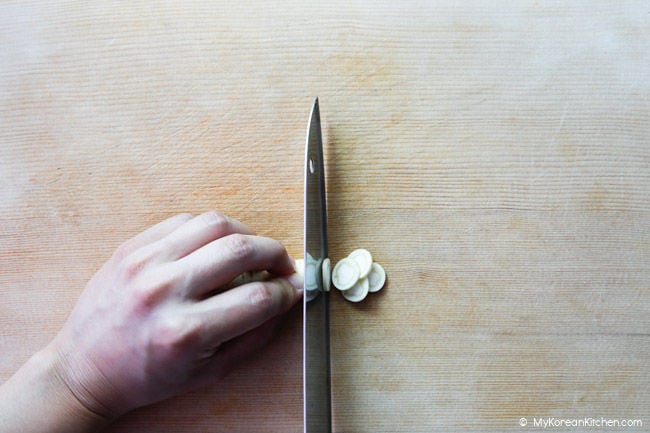
3. Wash the dried jujubes thoroughly under running cold water to get rid of any dirt or debris. Once they’re clean, dry them off completely.
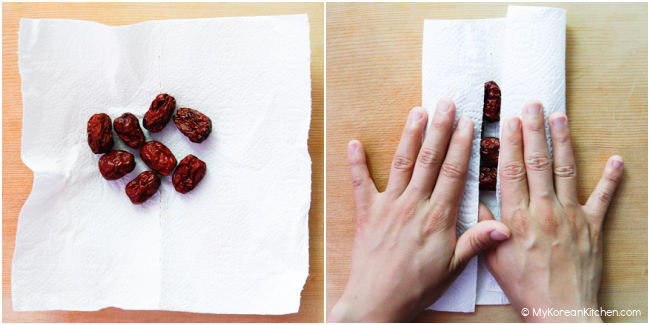
4. To cut the jujube, start by making a cut at one end of the fruit. Then, roll it up. Once you are done, slice it in 0.3 to 0.5 cm (0.1 to 0.2 inches) thickness.

5. Add sliced ginseng and dried jujube to a sterile jar, then add honey and close the lid. Leave the mixture at room temperature for one day, then transfer to the fridge. It will be ready to eat in one week, but if you can wait, it will be even better after four to five weeks when the flavor has had time to develop.
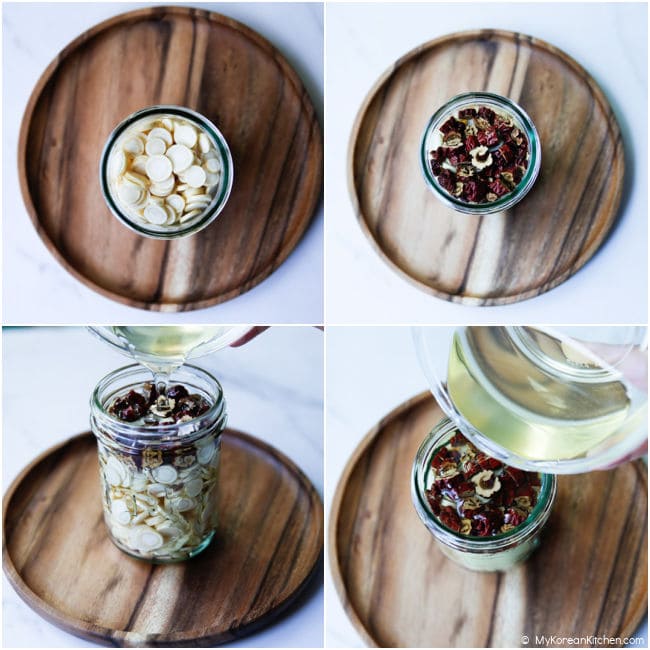
How To Serve
Add a few spoonfuls of ginseng tea to a cup, then add warm water. Stir well to drink.
You can also serve ginseng tea cold by mixing it with cold water or sparkling water. Some Koreans also mix ginseng tea with milk to make a ginseng latte.
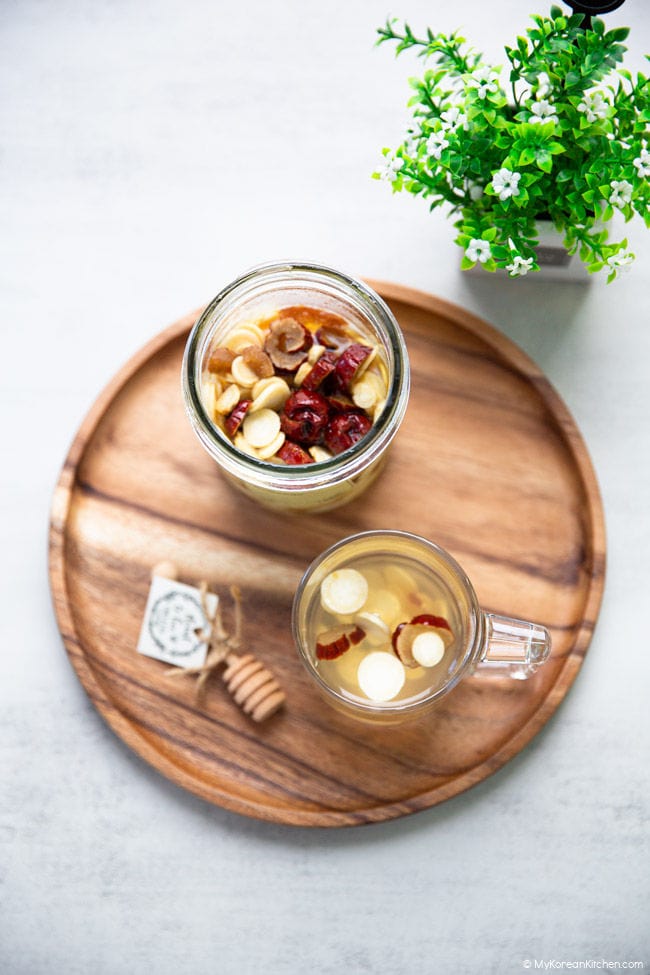
Traditional Method – Korean Ginseng Tea
Ingredients
- 50g / 1.8 ounces ginseng, cleaned & sliced thinly
- (optional) 10g / 0.4 ounces dried jujube, cleaned
- 2.5L water
- honey, to taste
* The ratio of water to ginseng is 500g/ 10g or 5:1. You can adjust the ratio according to your needs.
How To Make
1. Place water and ginseng in a pot. Add Chinese dates, and then bring it to a boil over high heat. Once boiling, reduce the heat to low and let it continue boiling for 20-25 minutes. After the specified time has passed, strain the ginseng and jujube from the liquid.
2. To serve, add a spoonful of honey to a cup. Pour the ginseng boiled water into it. Stir well and drink.
Other Korean Drink Recipes You Might Like
If you like Korean drinks, try these recipes below. These are some popular Korean tea recipes.
- Korean Plum Tea (Maesilcha)
- Barley Tea (Boricha)
- Citron Tea (Yujacha)
Love Korean food? Browse lots more Korean recipes from my easy Korean recipe collections. And subscribe to my newsletter for all of the latest updates including new recipes, what MKK communities are cooking and K-Dramas!
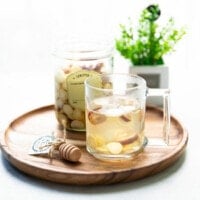
Ginseng Tea (Insam Cha)
Ingredients
- 150 g ginseng (5.3 ounces), fresh
- 20 g dried jujube (Chinese dates), (0.7 ounces), pitted
- 150 g honey to 225g (5.3 to 7.9 ounces)
Instructions
- Make sure to wash your ginseng thoroughly under running water. Use a small brush to scrub away any dirt or debris between the fine roots. Pat the ginseng dry with kitchen paper, and then let it air dry. It is important to dry ginseng well, so it doesn’t develop mold during storage.
- To prepare the ginseng, cut off the top end and discard it. Trim off the fine roots on the sides of the ginseng, and reserve them for other dishes (e.g. samgyetang). Slice the ginseng thinly. Some people like to finely chop their ginseng, but slicing gives a prettier finish.
- Wash the dried jujubes thoroughly under running cold water to get rid of any dirt or debris. Once they’re clean, dry them off completely.
- To cut the jujube, start by making a cut at one end of the fruit. Then, roll it up. Once you are done, slice it in 0.3 to 0.5 cm (0.1 to 0.2 inches) thickness.
- Add sliced ginseng and dried jujube to a sterile jar, then add honey and close the lid. Leave the mixture at room temperature for one day, then transfer to the fridge. It will be ready to eat in one week, but if you can wait, it will be even better after four to five weeks when the flavor has had time to develop.
Notes
- The above ingredients will fit in a 490ml container. Glass is recommended. Be sure to sterilize it well beforehand.
TO SERVE
- Add a few spoonfuls of ginseng tea to a cup, then add warm water. Stir well to drink.
- You can also serve ginseng tea cold by mixing it with cold water or sparkling water. Some Koreans also mix ginseng tea with milk to make a ginseng latte.
Nutrition Info (per serving)
The nutrition information shown is an estimate provided by an online nutrition calculator. It should not be considered a substitute for a professional nutritionist’s advice.
